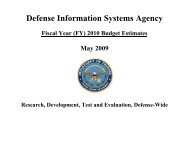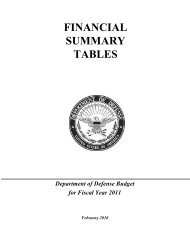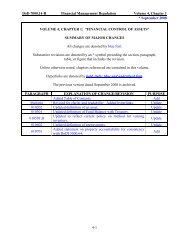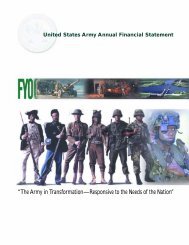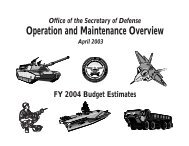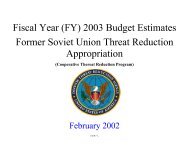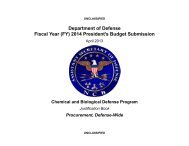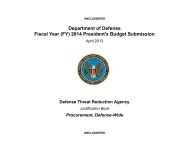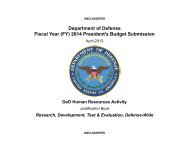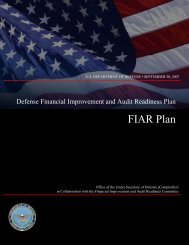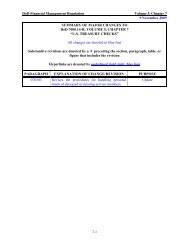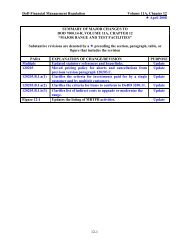department of defense agency financial report fiscal year 2012
department of defense agency financial report fiscal year 2012
department of defense agency financial report fiscal year 2012
You also want an ePaper? Increase the reach of your titles
YUMPU automatically turns print PDFs into web optimized ePapers that Google loves.
Department <strong>of</strong> Defense Agency Financial Report for FY <strong>2012</strong><br />
The Department recognizes excess, obsolete, and unserviceable inventory and OM&S at a<br />
net realizable value <strong>of</strong> $0 pending development <strong>of</strong> an effective means <strong>of</strong> valuing such<br />
materiel.<br />
Inventory available and purchased for resale includes consumable spare and repair parts,<br />
and repairable items owned and managed by the Department. This inventory is retained to<br />
support military or national contingencies. Inventory held for repair is damaged inventory<br />
that requires repair to make it suitable for sale. Often, it is more economical to repair these<br />
items rather than to procure them. The Department <strong>of</strong>ten relies on weapon systems and<br />
machinery no longer in production. As a result, the Department supports a process that<br />
encourages the repair and rebuilding <strong>of</strong> certain items. This repair cycle is essential to<br />
maintaining a ready, mobile, and armed military force. Work in process balances include:<br />
(1) costs related to the production or servicing <strong>of</strong> items, including direct material, labor, and<br />
applied overhead; (2) the value <strong>of</strong> finished products or completed services that are yet to<br />
be placed in service; and (3) munitions in production and depot maintenance work with<br />
associated costs incurred in the delivery <strong>of</strong> maintenance services.<br />
1.N. Investments in U.S. Treasury Securities<br />
The Department <strong>report</strong>s investments in U.S. Treasury securities at cost, net <strong>of</strong> amortized<br />
premiums or discounts. Premiums or discounts are amortized over the term <strong>of</strong> the<br />
investments using the effective interest rate method or another method that yields similar<br />
results. The Department’s intent is to hold investments to maturity unless they are needed<br />
to finance claims or otherwise sustain operations. Consequently, a provision is not made for<br />
unrealized gains or losses on these securities.<br />
The Department invests in nonmarketable market-based U.S. Treasury securities, which are<br />
issued to Federal agencies by the U.S. Treasury’s Bureau <strong>of</strong> the Public Debt. They are not<br />
traded on any securities exchange but mirror the prices <strong>of</strong> particular U.S. Treasury<br />
securities traded in the government securities market.<br />
The Department’s net investments are held by various trust and special funds. These funds<br />
include the Military Retirement Fund; Medicare-Eligible Retiree Health Care Fund; Other<br />
Defense Organizations General Fund trust and special funds; donations (gift funds); and the<br />
U.S. Treasury managed trust funds <strong>report</strong>ed by USACE including the South Dakota<br />
Terrestrial Habitat Restoration, Inland Waterways, and Harbor Maintenance Trust Funds.<br />
Other investments represent joint ventures with private developers constructing or<br />
improving military housing on behalf <strong>of</strong> the Department under the authority <strong>of</strong> MHPI,<br />
authorized by PL 104-106, Section 2801. These investments do not require market value<br />
disclosure. The Department’s potential losses on these ventures are limited to the amounts<br />
invested.<br />
1.O. General Property, Plant and Equipment<br />
The Department uses the estimated historical cost for valuing military equipment. The<br />
Department identified the universe <strong>of</strong> military equipment by accumulating information<br />
relating to program funding and associated military equipment, equipment useful life,<br />
program acquisitions, and disposals to establish a baseline. The military equipment baseline<br />
is updated using expenditure, acquisition, and disposal information.<br />
80<br />
Financial Information



